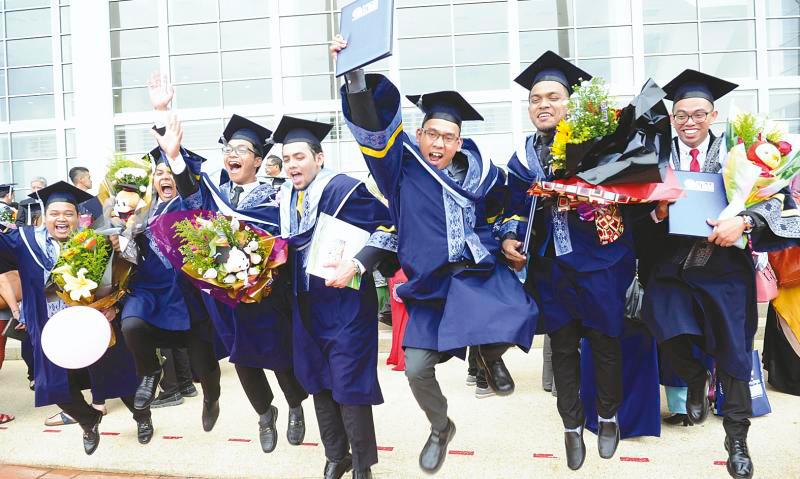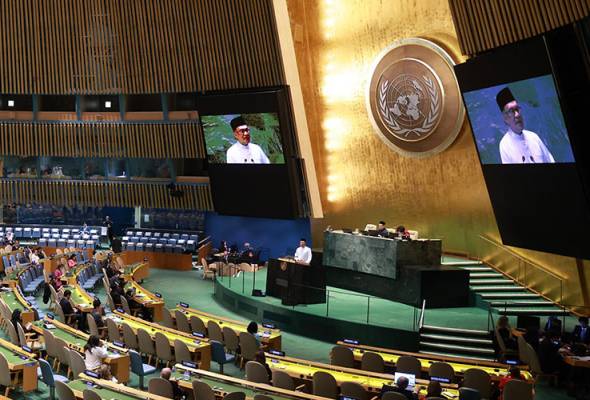
Published by AstroAwani, MYsinchew & theSundaily, image by theSundaily.
Underemployment is a growing problem, especially among graduates, amidst the emergence of flexible gig work and the lack of job opportunities in the labour market.
It implies the under-use of the labour force’s productive capacity.
Studies on mismatch occurrences in Malaysia focusing on graduates found that a significant proportion of graduates accept jobs that do not align with their fields of study.
According to job placements data 2022 under MyFutureJob released by Social Security Organization (Socso), approximately 40 per cent (nearly half) of graduates are underemployed in semi-skilled and low-skilled jobs (refer to “Grads ‘too good’ for their jobs”).
The DOSM categorised underemployment into skill-related underemployment and time-related underemployment.
Skill-related underemployment is when highly skilled workers work in low-paid or low-skilled jobs, usually not requiring a degree or diploma, whereas time-related underemployment occurs when the number of hours worked is below that of the worker’s availability and ability to work, commonly the threshold being 30 hours per week.
According to the latest graduate statistics 2021 by DOSM, there were 4.57 million employed graduates, of which 2.9% were time-related underemployed and 33.9% were skill-related underemployed.
From the above figures, it is apparent that Malaysia is facing mainly skill-related underemployment, which is a severe issue among those first time entering the employment market.
In recent years, an increasing trend can be seen in underemployment.
Several factors could be contributing to the rise of this phenomenon, all of which are interlinked.
There has been an increasing trend in the number of graduates from higher education in Malaysia since the implementation of educational reforms in the 1990s. Malaysia has significantly invested in human capital as it transformed from an agriculture-based economy to a modern service-based economy.
After all, education is unanimously recognised as closely linked to individuals’ ability, productivity, and future earning potential, incentivising people to invest in education. Also, the increasing demand for advanced qualifications in the job market compels people to pursue higher education to remain competitive in the labour market.
However, when an increase in tertiary-educated workers does not correspond to the flexibility of the labour market and a sufficient number of adequate jobs, there is a high possibility that these workers will end up underemployed.
Despite ongoing challenges in both the public and private sectors to generate and maintain a significant number of positions demanding graduate-level skills, Malaysian governments have consistently demonstrated a keen interest in producing many university and college graduates. This has led to a substantial mismatch between the number of graduates that industries can effectively absorb and the increasing surplus of graduates entering the workforce.
Reportedly, the labour market in Malaysia needs more high-skilled jobs to accommodate the growing number of educated workers.
Data has shown that most jobs in Malaysia are in the semi-skilled category. Employment Statistics Third Quarter 2022 by DOSM revealed that jobs in the semi-skilled category comprised 62.3% of total jobs during this quarter, while the skilled and low-skilled categories were 24.9% and 12.8%, respectively.
Compared with the figures from 2020, there is a decrease in skilled workers from 28.2%, an increase in the share of semi-skilled workers from 59.9% and an increase in the share of low-skilled employment from 11.9% – Source, DOSM. These figures should be worrying.
Since 2016, there has been a worrying downward trend in tertiary school enrolment in Malaysia, one of the reasons being the lack of high-skilled job opportunities (refer to “Malaysian Education Quagmire: Destruction of Current & Future Human Capital”). Nevertheless, a large number of high-skilled graduates enter the labour market every year, apparently, with no corresponding growth in high-skilled jobs but a decrease instead.
The rate of growth in high-skilled jobs, which is only 0.2% from the third quarter of 2021, is outpaced by the increase in the number of tertiary-educated labour force.
The jobs produced in Malaysia are mainly based on sectors that usually require low and medium-skilled jobs.
According to Employment Statistics Third Quarter 2022, the largest composition of jobs and filled jobs were in the Services sector, with a share of 51.9 per cent (4.50 million) and 52.7 per cent (4.47 million), respectively.
Regarding jobs created, 51.5 per cent were concentrated in the Services sector, followed by Manufacturing with a share of 32.0 per cent and Construction (11.5%).
This suggests the presence of a structural issue within the Malaysian economy characterised by a deficiency in high-skilled industries, causing a mismatch between skills and jobs.
Human Resources Minister V Sivakumar previously mentioned that early intervention is necessary for skills mismatch as failure to do so can result in as many as 4.5 million Malaysians losing their jobs by 2030 (“Graduate underemployment in Malaysia is a complex challenge with political implications” from August 9, 2023)
The disparity within the labour market resulting in the underutilisation of labour presents a severe problem for the nation — labour underutilisation imposes costs on individuals and the economy through reduced productivity and income loss. Investing in higher education in such an economy is akin to subsidising other economies because many of those who graduated with high skills and knowledge but could not find a matching job in the home economy turn into a “brain drain”. The inability to find a job matching the skills level has been consistently found by empirical research to be one of the forces fuelling Malaysian brain drain (refer to “Malaysian brain drain – don’t go chasing waterfalls”).
A shortage of available jobs often intensifies competition in the labour market, prompting individuals to turn to gig work as an alternative. While gig work offers greater flexibility and the potential for higher earnings, it is still categorised as underemployment since these positions often do not fully utilise an individual’s qualifications or align with their career aspirations and, therefore, do not contribute to national development.
With data on job mismatch in Malaysia being limited to date, it is highly critical for the government to ensure that up-to-date and accurate information on this issue is available, as underemployment usually underestimates the unemployment rate.
While this article primarily discusses underemployment among youth and graduates, it is essential to recognise that underemployment affects not only this demographic.
Hence, it is vital to explore determinants of underemployment to gain better insights into who is most susceptible to this social issue within society, enhancing our understanding of its significance.
Numerous research findings have demonstrated that a person’s educational background, age, work experience, gender, and marital status are important factors in determining the likelihood of underemployment.
For example, research indicates that both time-related and skill-related underemployment are more prevalent among women than men. Women frequently choose jobs that offer flexibility but lower pay to accommodate their family caregiving duties. Additionally, females with children face an increased risk of underemployment because of their parenting responsibilities (Ting et al., 2020).
Marital status is significantly related to time-related underemployment, where married workers with children are less likely to be time-related underemployed than single persons (Sukanya and Patcharawalai, 2019).
Underemployment has several profound negative impacts on individuals, families, and the broader society, be it economic, social, or psychological in nature.
Misalignment of the actual jobs and skills will stagnate career development, limiting opportunities for skill development and professional growth.
Underemployment may make it difficult for people to obtain future jobs in their desired field, turning it into a chronic condition, as their skills and experience may become outdated or irrelevant over time (remarkably quickly in the 4IR era).
One of the most immediate consequences of underemployment is financial strain, as the underemployed may struggle to make ends meet or support themselves and their families. This can lead to increased debt, poverty and even homelessness in some cases.
Prolonged underemployment as a chronic condition and persistent differences in underemployment between different education, gender and domicile groups may intensify income inequality.
Underemployment can also have negative mental health consequences, including depression, anxiety disorders and substance abuse, as people may experience feelings of frustration, stress, and anxiety due to their work situation.
Persistent underemployment can lead to social discontent and unrest as people and communities become frustrated due to limited opportunities and economic inequalities.
Various reforms in policies and the formation of adaptive strategies for job seekers are necessary to combat underemployment in Malaysia.
To bolster skills development and address workforce needs, it is imperative to invest in vocational and technical education programs (TVET), equipping individuals with relevant skills for in-demand jobs. Despite various government labour market empowerment initiatives such as the employment transition programme for TVET graduates, there is a need for additional efforts to better promote them to the public using innovative approaches (for details, refer to the earlier article by EMIR Research titled “Malaysian Education Quagmire: Destruction of Current & Future Human Capital”). Simultaneously, it is essential to promote lifelong learning by offering incentives for adults to continuously upskill and reskill, ensuring adaptability in their careers (“High skill-related underemployment reveals structural issues in the labour market”).
Supporting entrepreneurship with financial aid, mentoring, and start-up incubators promotes job creation, skills development, and the growth of new industries, fostering economic diversification. A diversified economy provides more job opportunities, reducing underemployment risks in specific sectors.
The government could also enhance job-matching platforms such as MyFutureJob to broaden their reach and effectiveness in connecting job seekers with suitable opportunities as well as provide job counselling and placement services, assisting individuals in discovering roles that align with their skills and aspirations, thus fostering more meaningful and fulfilling career paths (refer to “Socso committed to ensuring implementation of Budget 2023 initiatives”).
A crucial step in addressing underemployment is a shift in the economy’s structure. With a growing number of educated individuals, there must be a simultaneous increase in high-skilled job opportunities for optimal utilisation of the workforce. To achieve this, the economy needs to transform by promoting promising sectors that are experiencing high growth and have high-skilled labour demand worldwide like technology, green energy, and advanced manufacturing, which can drive economic growth. Urgent action is needed to transition low-productivity, low-skilled sectors into high-productivity, high-skilled ones.
Underemployment is a serious problem with far-reaching consequences for individuals, families, communities, and the economy. Addressing underemployment requires a multifaceted approach that involves both individuals and policymakers, focusing on strategies that support job creation, workforce development, access to information and resources, and career counselling.
Dr Rais Hussin and Chan Myae San are part of the research team at EMIR Research, an independent think tank focused on strategic policy recommendations based on rigorous research.

